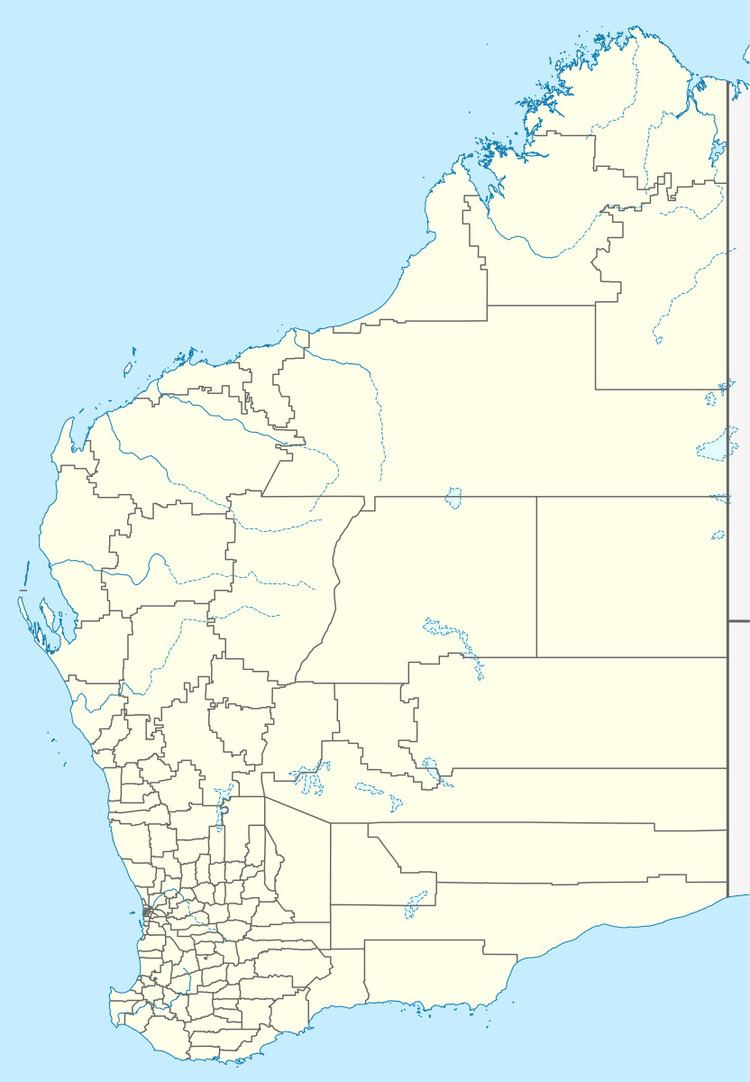 | ||
Address Rawlinna WA 6434, Australia | ||
Rawlinna Station is a pastoral lease and sheep station located about 339 kilometres (211 mi) east of Kambalda in the Goldfields-Esperance region of Western Australia. The locality of Rawlinna and the Transcontinental Railway are situated along the boundary of the station.
Contents
Description
The station occupies an area of about 8,000 square kilometres (3,089 sq mi) or 2.5 million acres in the remote south east of Western Australia, making it the largest sheep station in Australia. It is currently owned by the Jumbuck Pastoral Company. The station encompasses part of the Nullabor Plain, so the geology changes from the red dirt of the goldfields to the plain's famous white limestone outcrops. The vegetation changes from woodlands to the east to drought-resistant shrubs and grasses on the plain.
Feral dogs are a problem for graziers on the Nullarbor, so a 3 metres (10 ft) dog-proof fence was constructed with marsupial netting at the base; it is 370 kilometres (230 mi) in length. A separate 900 square kilometres (347 sq mi) block adjoins the fence that is also dog proofed with a solar powered electric fence. Stock are watered from 37 bores in 87 main paddocks, along with other holding paddocks. Some of the bores are 140 metres (459 ft) deep and are all powered by windmills.
A homestead exists about 11 kilometres (7 mi) south west of the railway siding. A huge shearing complex, known as the Depot Outstation, was built in the middle of the property in 1967. The outstation has a 16-stand shearing shed, an overseer's house, shearers' and station hands' accommodation, mess and kitchen facilities.
History
The traditional owners of the land are the Mirning people, the Ngalea and Wangai peoples, who have inhabited the area for over 10,000 years.
John Eyre and his companion Wylie passed through the area as they crossed the Nullarbor in the expedition of 1841. Eyre commented that the Nullarbor was "a blot on the face of nature".
Established in 1962 by Hugh G. MacLachlan, of the South Australian pastoral family, the station has a comparatively short history compared to other properties of its type around Australia.
Through the late 20th century the area proved to be prime pastoral and breeding country when seasonal conditions were good. In those days the station held between 40,000 to 60,000 sheep, and annually produced 1100 to 1700 bales of wool.
In 2001, an amount of 78,417 sheep were shorn for 2177 bales of wool. In 2014 around 53,000 sheep were shorn and 1285 bales of wool.
The station had a poor season in 2005, with only 4 inches (102 mm) of rain falling compared to the average of 9 inches (229 mm). By 2006 things had improved, with 6 inches (152 mm) falling before the onset of winter, guaranteeing that winter grasses would germinate and stock of 32,000 sheep on the property at that stage would have adequate feed.
Ross Wood, the station manager, retired in 2007. Wood was the third manager employed at Rawlinna since 1967, the other two being David Seaton and Murray McQuie. The station manager in 2012 was Michael Simon, who had replaced Wood in 2007. Simon started with Jumbuck in 1983 and now runs Rawlinna along with 14 staff. The property is stocked with approximately 60,000 sheep, with wool being sent to Adelaide for testing and sale. The record number of sheep shorn at Rawlinna is 80,000.
